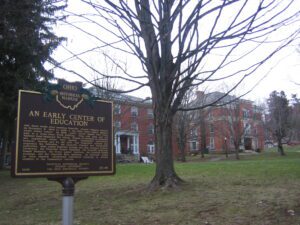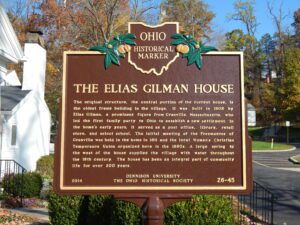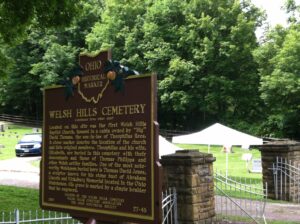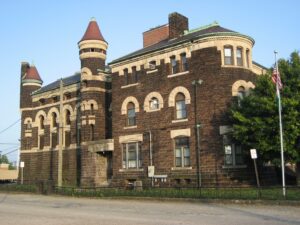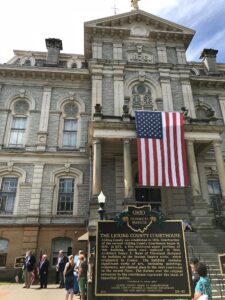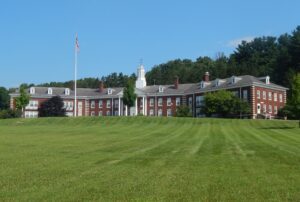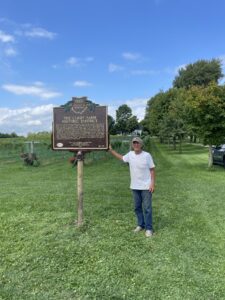, OH
Just three weeks after reaching Granville, pioneer villagers decided on December 9, 1805 to build a log cabin where eighty children would attend school. By 1820, public school classes were being held in a three-story brick building. When rail lines and the National Road bypassed the village, dreams of becoming an industrial and commercial center were dashed. Educational institutions, however, thrived and by the Civil War Granville’s citizens had organized the following: the Granville Literary and Theological Institution, later called Granville College and then renamed Denison University; the Granville Female Seminary, the Granville Episcopal Female Seminary, the Young Ladies’ Institute, the Granville Female Academy, and the Granville Male Academy. As Granville enters its third century, educational excellence continues to attract students to the community’s schools.
, OH
The original structure, the central portion of the current house, is the oldest frame building in the village. It was built in 1808 by Elias Gilman, a prominent figure from Granville Massachusetts, who led the first family party to Ohio to establish a new settlement . In the home’s early years, it served as a post office, library, retail store, and select school. The initial meeting of the Freemasons of Granville was held in the home in 1811 and the local Women’s Christian Temperance Union organized here in the 1880s . A large spring to the west of the house supplied the village with water throughout the 19th century . The house has been an integral part of community life for over 200 years.
, OH
Welsh Hills Cemetery was once part of the United States Military Tract given to veterans of the Revolutionary War. The land was owned by a Philadelphia Welshman named Samson Davis. On September 4, 1801, a portion of his land was purchased by the co-founders of the Welsh Hills community, Theophilus Rees and Thomas Philipps, who came from Carmarthenshire, Wales. On February 6, 1808, Theophilus Rees donated a portion of his land for the establishment of this cemetery. On that same day, Rees Thomas, the 8-year-old grandson of Theophilus Rees, became the first person interred. (Continued on other side)
, OH
Designed by J. W. Yost, a renowned Ohio architect, the jail first opened for use in 1889. The Richardsonian Romanesque structure cost $120,000 to build. It was constructed of pink sandstone known as “brownstone,” which was quarried near Millersburg, Ohio. The front three levels were built to house the families of the sheriff and the jail matron. Sheriff Andrew Crilly was the first to occupy the sheriff’s quarters when the jail opened. The rear portion of the building was used for the incarceration of male and female prisoners on separate floors. The 32 cells, each a minimum of 8′ x 8′ in size, had an official total capacity of 68 prisoners. However, well over that number were housed here at times. The jail building was last used for incarcerations in 1987. (Continued on/from other side)
, OH
Licking County was established in 1808. Construction of the current Licking County Courthouse began in 1876. In 1879, a fire destroyed upper portions of this building, which was replaced in 1880. Architect Henry E. Myer of Cleveland designed the building in the Second Empire Style, which originated in France. The building contains significant works of art, including paintings, sculptures, and stained glass in the west courtroom on the second floor. The statues over the original entrances to the courthouse represent the ideal of impartial justice. (Continued on/from other side)
, OH
Tuberculosis, or TB, is a contagious disease that was responsible for the deaths of one out of every seven people in the U.S. in the early 20th century. The Licking County Tuberculosis Sanatorium, known as the TB San, was constructed in 1931-1932 at a cost of $250,000. The facility kept TB patients separate from the general population, controlling the spread of disease. The location provided patients with rest, fresh air, food, and exercise, the main treatments for TB in the 19th through mid-20th centuries. (Continued on other side)
, OH
George Curry (1819-1885) was one of seven children born to a tenant sheepherder in the Cheviot Hills of Scotland. He immigrated to Ohio during the 1840s and married Scottish immigrant Agnes Milligan (1830-1893) in 1855. The couple moved to Licking County in 1865, and purchased 160-acres of farmland in 1873 to establish a sheep farm. They soon became known for their fine Spanish Merino herd. In the late nineteenth century, Ohio was a leader in the wool trade, with Licking County leading the state’s wool production by 1870. At the time of his death, George Curry was “a well-known stock dealer, and was greatly esteemed” in the community. Five generations of George and Agnes Curry’s family lived and farmed their Licking County land, until it was divided into parcels and sold in 1979.


